BEE LOVED
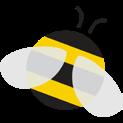
Celebrating1OO Years
of the Scripps National Spelling Bee


of the Scripps National Spelling Bee
BY BEN BERNANKE
Igrew up in Dillon, South Carolina, a small rural town in the northeast corner of the state. We had to win grade, school and county spelling bees to get to the state competition. As I recall, the prize from winning the county spelling bee was $15, which I thought was pretty impressive at the time.
I was in the sixth grade when I participated in the state spelling competition. My parents went with me. In the middle of the competition a potential disaster struck. I was asked to spell ludicrous , and I slurred my answer. They didn’t hear the o in the last syllable, and so the judges ruled me out. When I sat with my parents, I asked them, “How do you really spell this?” They showed me the correct spelling, and I said, “That’s what I said. They didn’t hear me correctly.”
My mother said, “You can’t do anything about it now.” I said, “Yes, I can.” I got up and went up to the judge. I interrupted the proceedings and said I spelled the word correctly. There was resistance at first. Then they said, OK, we’ve taped it. They played the tape four times or so, and they decided that, in fact, I had said, R-O-U-S, and they put me back into the competition, which I went on to win.
Going to the 1965 Scripps-Howard National Spelling
Bee was an exciting experience, a growing experience. I had never been to Washington, D.C., before. It was my first time on an airplane. It was interesting to meet other spellers and families from around the country.
I did little to no studying for the Bee, but I was a good speller because I read voraciously, and I had an interest in word origins. For me, reading and learning new words was a window to the wider world from the small town where I grew up.
There were 70 contestants in the national bee, and I made it through the first day.
On the second day, the word I got was edelweiss. It’s a Swiss flower. It’s the name of a song in the movie, “The Sound of Music,” which was very popular when it came out in 1965. Dillon did not have an operating movie theater, and I had not seen the movie. I’d never heard of an edelweiss before, so I misspelled it and was eliminated from the national bee. I finished 26th. I
was disappointed because the winner got to be recognized in the audience by Ed Sullivan at his TV show. So, I missed out on that.
Overall, though, it was a great experience for me. It showed me new horizons and helped me build confidence. And I met a lot of interesting people.
In the 60 years since the spelling bee, I have traveled all over the world. I have been on every continent and in most countries, including some obscure ones, partly because of my role as a government official. I’ve always
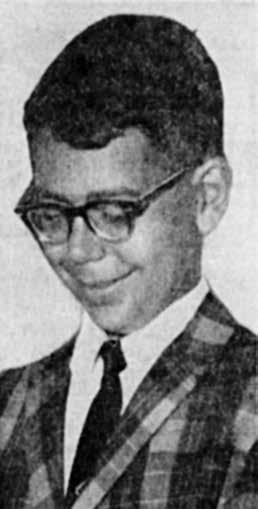
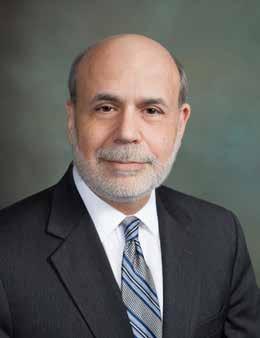
enjoyed seeing other cultures, hearing other languages, meeting people from other countries. The national bee was my first experience like that.
It’s impressive that the Bee is 100 years old. It suggests an ongoing fascination among young people with words and language, and, by extension, reading and learning about other cultures and other languages.
It’s funny. When Time selected me as Person of the Year in 2009, the article referred to me as “the most powerful nerd on the planet.” That’s who I was. I was a professor whose job was reading and talking. I thought that I was going to be a professor for my whole career, until I got a call to be on the Board of Governors of the Federal Reserve.
I think being called a nerd is a compliment. Nerds advance ideas, they love intellectual challenges and drive innovation. Some become artists and contribute to our culture. We need nerds. And to the extent that the Scripps National Spelling Bee celebrates nerds, I think it’s great. I am proud to be a part of that club.
Ben Bernanke was chair of the Federal Reserve from 2006 to 2014 and won the Nobel Prize for Economic Sciences in 2022. He is widely considered one of the nation’s most influential economists and presently is a distinguished senior fellow at the Brookings Institution in Washington, D.C.
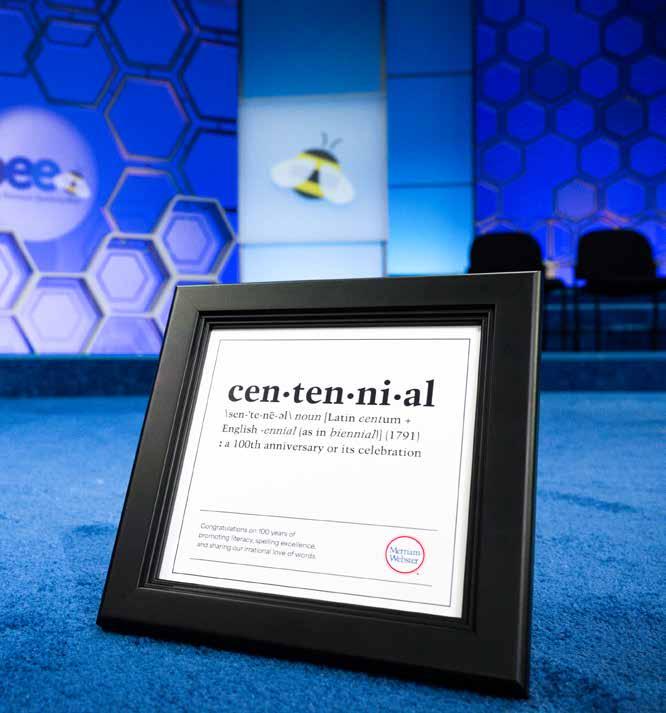
53 GIRLS
57 BOYS
32 14-YEAR-OLD CHAMPIONS
13-YEAR-OLD CHAMPIONS 20 12-YEAR-OLD CHAMPIONS
5
YEARS THAT MULTIPLE CHAMPIONS WON 1950, 1957, 1962, 2014, 2015, 2016, 2019
6
MOST NATIONAL COMPETITIONS
Akash Vukoti (2016, 2018, 2019, 2021-2023)
5 CHAMPIONS WHO WON AFTER PLACING SECOND
Betty Robinson (1926, then 1928)
Sandra Owen (1956, then 1957)
Paige Pipkin (1980, then 1981)
Sean Conley (2000, then 2001)
Faizan Zaki (2024, then 2025)
SPELLERS WHO WON IN THEIR FIFTH APPEARANCE AT THE BEE
Katharine “Kerry” Close (2006)
Sriram Hathwar (2014)
Vanya Shivashankar (2015)
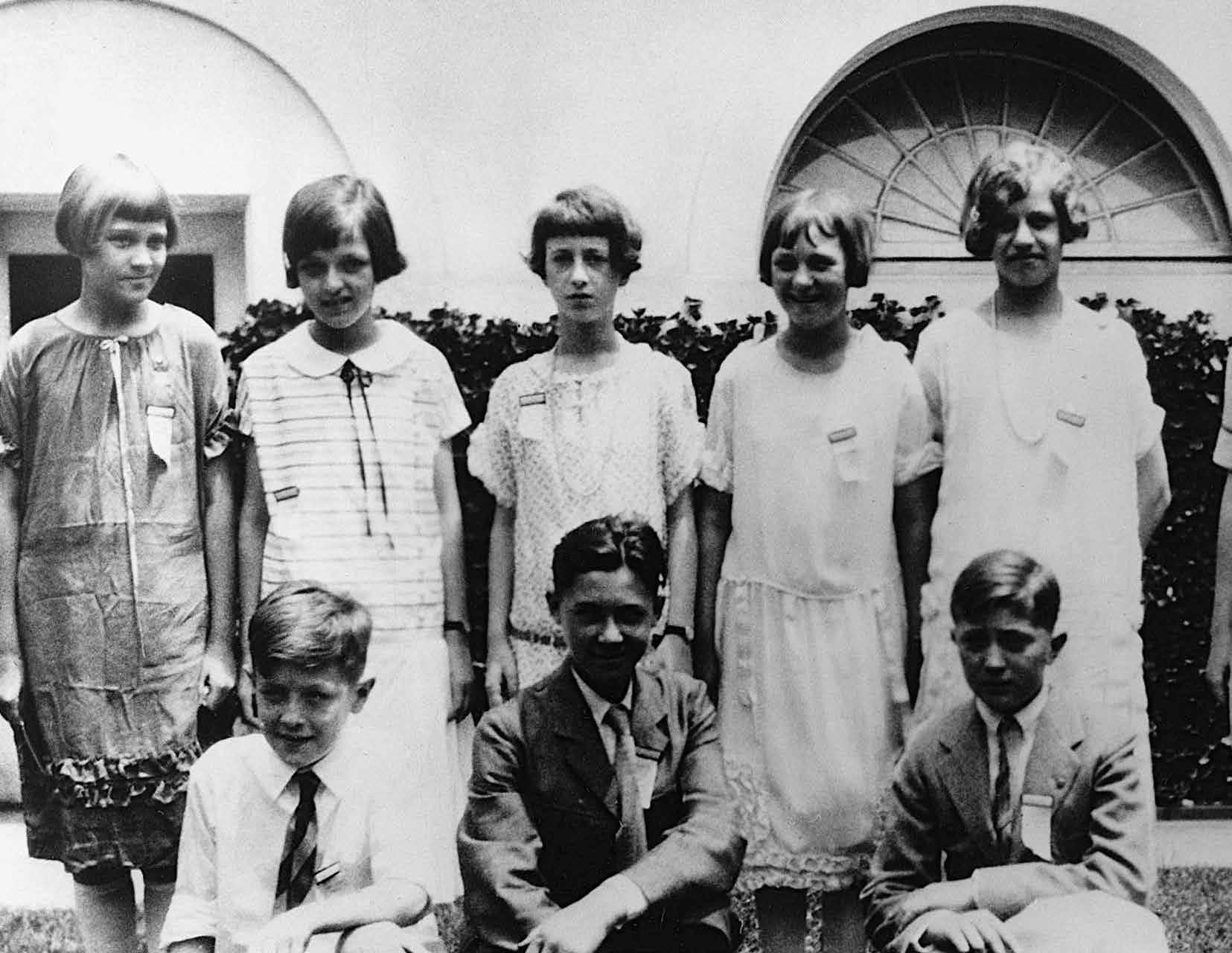
Finalists of the first National Spelling Bee, held on June 17, 1925, in Washington, D.C. Front, left to right: Patrick Kelly, New Haven, Connecticut; Lorin Mackey, Oklahoma City; Frank Neuhauser, Louisville, Kentucky. Back, left to right: Almeda Pennington, Houston; Edna Stover, Trenton, New Jersey; Mary Daniel, Hartford, Connecticut; Mary Coddens, South Bend, Indiana; Dorothy Karrick, Detroit; Helen Fisher, Akron, Ohio.

What a fortunate coincidence for Frank Neuhauser that his family grew gladiolus flowers in Louisville, Kentucky, because that was the 11-year-old’s winning word in the first National Spelling Bee in 1925. (Read more on page 15.)
That, as they say, was just the beginning of an educational and cultural tradition that now spans 100 years.
In the first Bee, there were nine spellers. By the end of the 1920s, there were 21 newspaper
sponsors sending spellers to the national competition — from Maine to Nebraska.
Those first spellers met with Presidents Calvin Coolidge and Herbert Hoover; went to Mount Vernon and Arlington National Cemetery; and saw the partially constructed National Cathedral, which was only completed in 1990.
Helen Fisher of Akron, Ohio, finished third in 1925 and went on to travel the world as a United Press International correspondent. Twenty-five years
later, she would say that the National Spelling Bee was her “first big step into the outside world,” a statement that would be echoed by the many thousands of spellers who followed her onto that stage.
The first Black American participated in 1926: Sarah Louise Van Allen, from West Boylston, Massachusetts. She was sponsored by the Telegram-Gazette newspaper of Worcester, Massachusetts.

1947 champion Mattie Lou Pollard of Georgia comforts runner-up Sonya Rodolfo of Chicago, who had come to America from the Philippines only two years earlier. “I wish that you had won,” Pollard told her.
OPPOSITE : Runner-up Mary McCarthy on the 1946 NBC broadcast, the first live televised broadcast of the National Spelling Bee.
In 1940, the Louisville Courier-Journal decided to give up managing the National Spelling Bee after 15 years. At the time, multiple Scripps-Howard newspapers had been actively participating in the national competition.
In a November 1940 internal memo, Max B. Cook, then the promotion editor of Scripps-Howard Newspapers, wrote: “Several participating ScrippsHoward newspapers and a number of outside papers have urged Scripps-Howard to take it over. The editors point out that it has proved ‘too valuable to drop by the wayside.’”
He added the event “can be easily handled” and would be “well worthwhile to put the Scripps-Howard label on it.”
There was agreement on that last point.
Scripps-Howard — now The E.W. Scripps Company — indeed took over stewardship of the Bee in 1941. Not much changed in that first year for the 17th Bee. It remained at the National Press Building auditorium and had 29 participants, up seven from the year before. Press releases for the 1941 Bee said: “It has
proved itself — especially under present conditions — as one of the best good will promotions possible,” and that the Bee was “a fine antidote for the war news.”
Now, 84 years later, the Scripps National Spelling Bee is an American cultural staple. It certainly has grown through the years with more than 240 competitors in 2025.
“Having the family’s name associated with the spelling bee, an event that encompasses the drive for learning, perseverance and growth, is the very essence of what the family supports and encourages,” said Monica Holcomb, a direct descendent of E.W. Scripps and a member of Scripps’ Board of Directors. “It means a great deal to me that this company supports educational endeavors that are meaningful, inspiring and have positive long-lasting impacts for all involved.”
With Scripps managing the event, it went from being not televised to being broadcast on national networks, including NBC, PBS, CNN, ESPN and, most recently, ION, the Scripps-owned national sports and entertainment network that reaches almost every U.S. TV household.

Founded in 1878, Scripps has evolved over the years, from
primarily owning newspapers to mostly broadcasting properties today, with more than 60 local television stations in over 40 markets plus national news and entertainment networks and a sports division.
“Most of the media businesses operated by my family over the years have never included the family name,” said Marilyn J. Scripps, an entrepreneur, philanthropist and urban revivalist whose Cincinnati-based Rookwood Pottery started making the Scripps Cup champion’s trophy in 2019. “That may be one reason why my cousins and I all speak so fondly about the Scripps National Spelling Bee. It has been a constant in an ever-changing media landscape, and it has forever associated ‘Scripps’ with scholastic excellence. It makes me proud when I think of the millions of students who have studied hard and aspired to high academic achievement because of a program that carries the name Scripps.”
Scripps has a dedicated full-time team, led by Executive Director Corrie Loeffler, and receives yearround support from most Scripps divisions. Many Scripps employees support the Bee on site each year.
Holcomb and Marilyn Scripps have attended several Bee Weeks over the years. Holcomb said she enjoys the shared unity and purpose and values being “a part of a remarkable experience that is meaningful and enriches everyone involved.”
John Paola from Pittsburgh wins the 1977 Scripps-Howard National Spelling Bee after finishing 22nd in 1976.
BELOW: Paola gets to meet Frank Neuhauser, left, the first National Spelling Bee champion. They are pictured with Bee Director James H. Wagner.
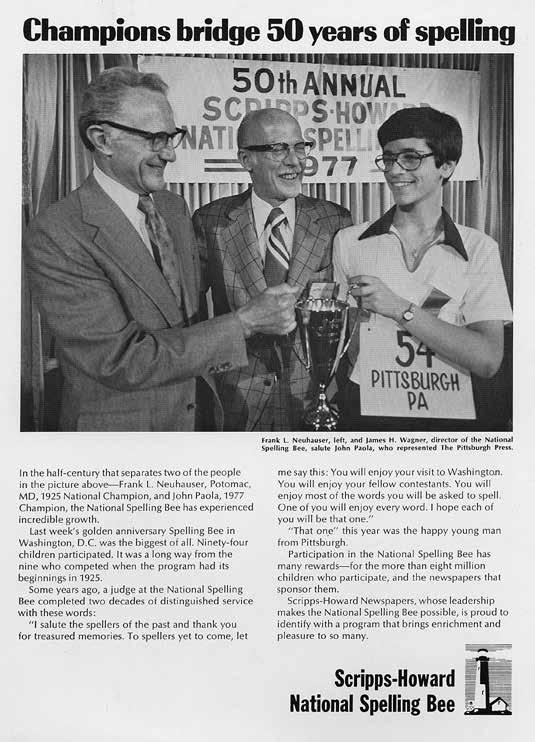


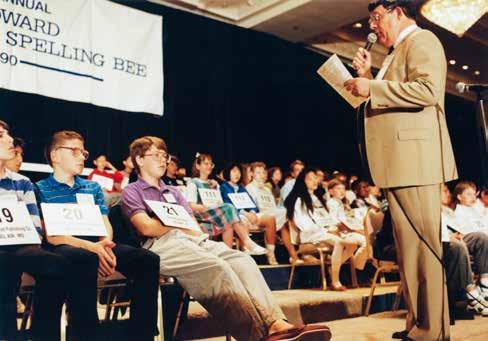
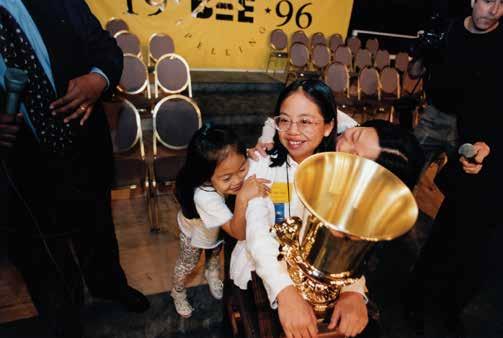
ABOVE : Longtime Bee Pronouncer and University of Dayton English professor Dr. Alex Cameron addresses spellers in 1990.
ABOVE RIGHT: Wendy Guey celebrates with sisters Lynne, left, and Emily after her victory in 1996. Emily spelled in 1995 alongside Wendy, who was a four-year repeater; Lynne competed in 2003.
RIGHT: Corrie Loeffler, far right, performs a kickline with Vauhini Vara, second from left, Kimberly Stokes, second from right, and other spellers and siblings at the 1994 Memorial Day BBQ at Gunston Hall in Lorton, Virginia.
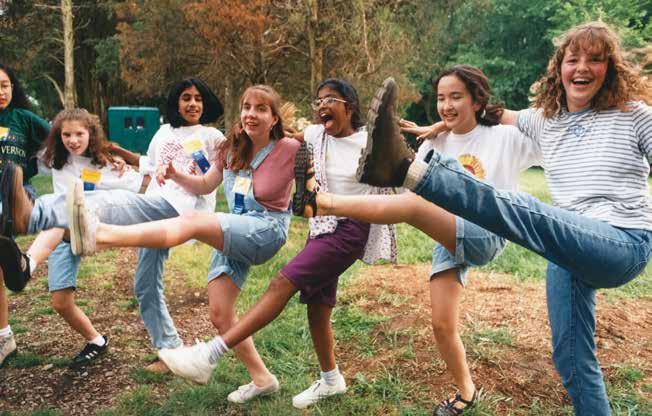

Prize money for the Bee champion grew from $1,500 in 1989 to $10,000 in 1998.
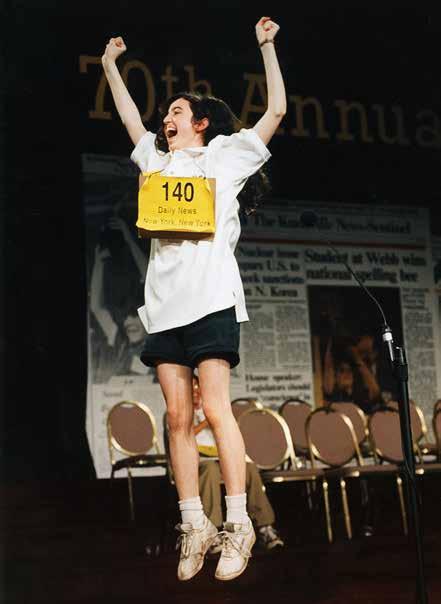
THIS PAGE : Rebecca Sealfon spells euonym to win the 70th ScrippsHoward National Spelling Bee, becoming the first homeschooled champion. She had previously finished in a tie for eighth in 1996.
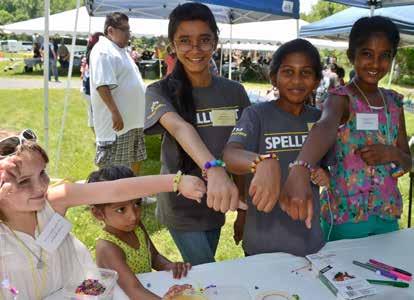
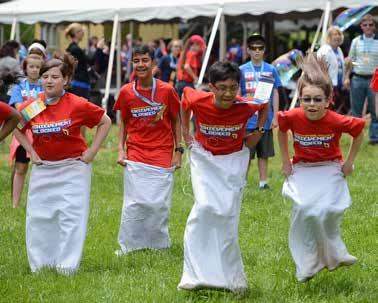
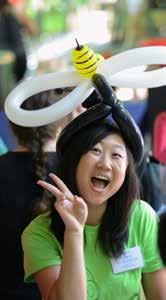
ABOVE : Spellers show off their arts and crafts bracelets at the 2014 Memorial Day picnic.
ABOVE MIDDLE : A sack race at the 2016 Memorial Day picnic.
ABOVE FAR RIGHT: Naomi Li from Center Valley, Pennsylvania, wears her bee balloon hat in 2012.
BOTTOM FAR RIGHT: Spellers and family members enjoy the 2012 Memorial Day picnic.
Sisters Jordan, left, and Sophia Hoffman are flying high in 2015.
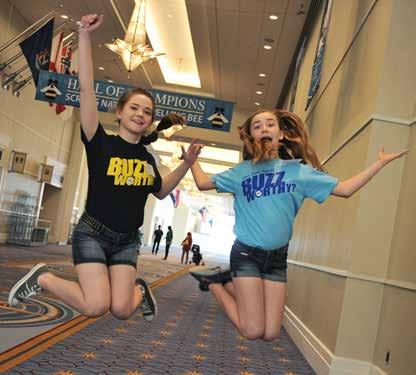
There were nine sets of twins in the 2019 competition.
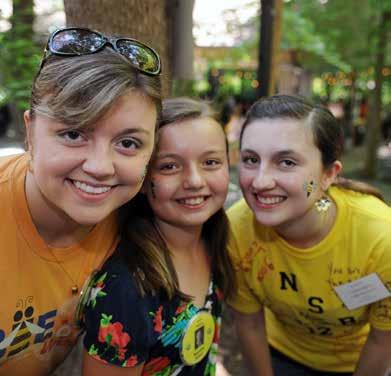

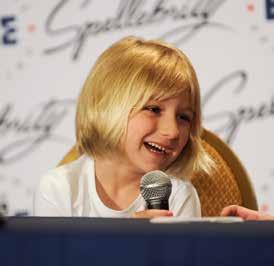
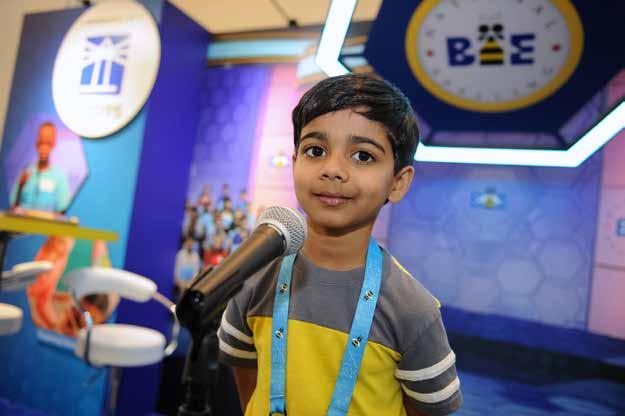
Three spellers in this decade — Lori Anne “Fox” Madison, Akash Vukoti and Edith Fuller — became the youngest participants in Scripps National Spelling Bee history. Madison was 6 years, 6 months old when she came to Bee Week in 2012. Vukoti qualified for the Bee when he was 6 and turned 7 during Bee Week in 2016. And then there was Fuller, who was 5 when she earned a spot in the national competition. She was just 6 years, 1 month old at the time of the 2017 Scripps National Spelling Bee and remains the youngest competitor ever.
RIGHT: Dev Shah from Tampa wins the 2023 Bee. Runner-up Charlotte Walsh is behind to the right.
OPPOSITE : Nine former champions gather at the 2024 Bee. Back row, Barrie Trinkle, George Thampy, Dr. Jacques Bailly, Sameer Mishra; front row, Dr. Kavya Shivashankar, Harini Logan, Dev Shah, Zaila Avant-garde and Vanya Shivashankar.
BELOW FAR RIGHT: Walsh from Merrifield, Virginia, competed in three Bees, finishing second in 2023, tied for 32nd in 2022 and tied for 51st in 2019.
BELOW RIGHT: Shah also competed in the 2019 and 2021 Bees.
BELOW: The 2023 Bee Keeper magazine cover.

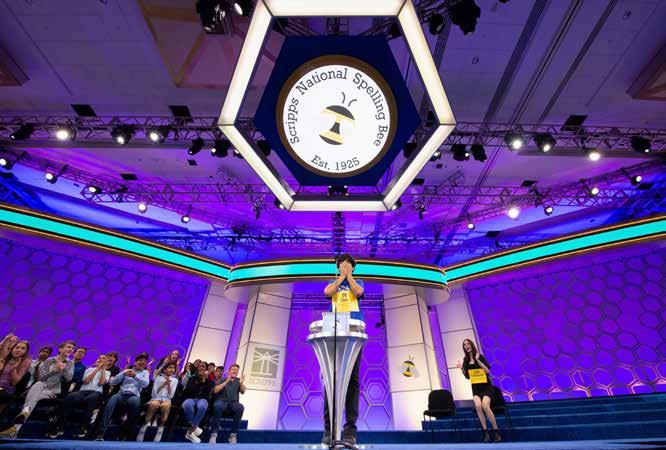
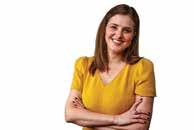
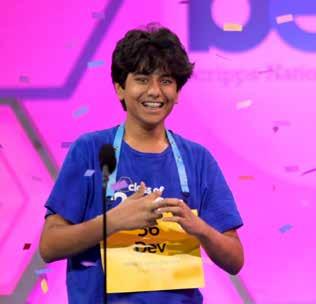
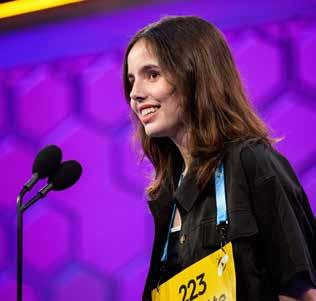

This was the first time the Scripps National Spelling Bee attempted to assemble its former champions en masse. All living champions were invited to the 2025 Bee, and 41 attended. A special poster was created with photos of former champions, and Bee-Con was an opportunity for the Class of 2025 to get signatures on the posters as past winners sat together at tables.
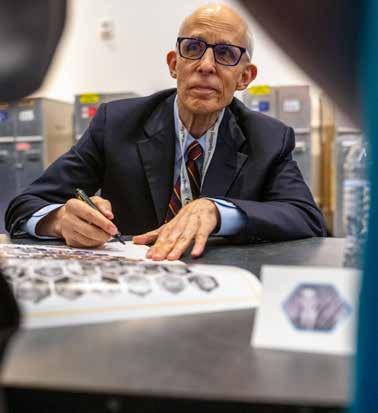

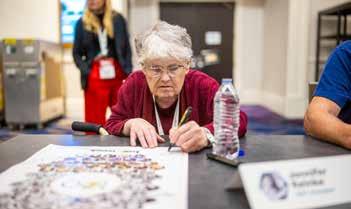
page 48.
page 48.
50.
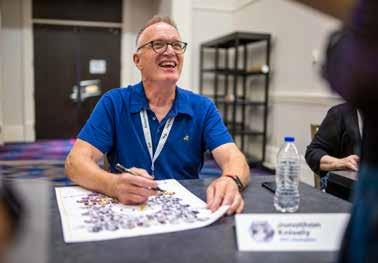


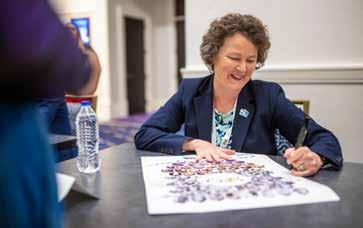

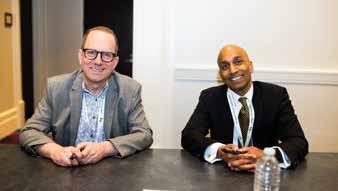
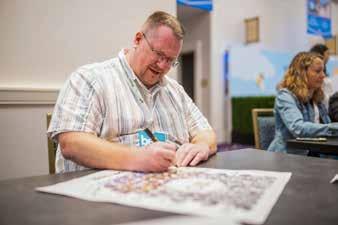
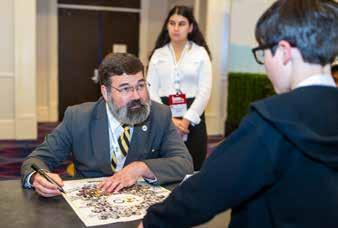
CLOCKWISE FROM TOP LEFT:
John Paola (1977) is also pictured on page 64.
Dan Greenblatt (1984) and Balu Natarajan (1985) share a table during the signing. Greenblatt is also pictured on page 69, and Natarajan is on page 72. You can read more about Natarajan on page 71.
Scott Isaacs (1989) is also pictured on page 75.
Ned Andrews (1994) signs for a speller. He is also pictured on page 81.
Molly Dieveney Baker (1982) and Blake Giddens (1983) share a table. Dieveney Baker is also pictured on page 69, and Giddens is on page 66.
Peg McCarthy (1978) signs for a speller. She is also pictured on page 62.
The Scripps National Spelling Bee’s legacy of spellers from outside the 50 United States dates back more than 65 years. “Why do we have international participation? There is tradition,” said Corrie Loeffler, the Bee’s executive director. “It’s a world-broadening experience for the kids from the U.S. who meet students from other countries with a window into other cultures. And, of course, it’s an opportunity for the kids who come here from other countries to learn about the U.S.”
Here are some fun facts:
• Over the years, there have been spellers from American Samoa, the Azores, the Bahamas, Brazil, Canada, China, England, Germany, Ghana, Guam, Italy, Jamaica, Japan, Mexico, the Netherlands, New Zealand, Norway, Puerto Rico, Saudi Arabia, South Korea, Spain and the U.S. Virgin Islands.
• The first known speller from outside the U.S. was Fred Souk from the Azores, who represented Stars and Stripes of Europe in 1957. The Azores is a series of nine volcanic islands that is a region
of Portugal. Souk was an American who previously lived in North Carolina. He finished in sixth place in 1957.
• The first non-U.S. citizen was 1959 South Texas Bee champ Gerardo Aguirre, according to a Corpus Christi Caller-Times article. Aguirre was from Nuevo Laredo in Mexico, right across the border from Laredo, Texas.
• Michael Gifford was the first speller from Guam in 1965.
• The first speller from South America was John Fawcett, in 1976, an American living in São Paulo, Brazil, whose father was a missionary. The Brazil Herald of Rio de Janeiro-Sao Paulo was the sponsor.
• Germany and Italy are among countries in Europe that have had the most spellers through the years, with 25 spellers hailing from Germany
Malek Youssri, 13, an eighth grader representing Gulf University for Science & Technology in Mubarak Al-Abdullah, Kuwait, in 2025 was the first speller ever from Kuwait. He was first in line to collect signatures of the 40 former champions in attendance during Bee-Con.
FAR RIGHT: Amazing-Grace Salami, 12, a sixth grader representing Spellingbee In Nigeria from Lagos, Nigeria, in 2025 was the first Nigerian speller.
since its initial representation in 1989. Spellers from European countries, often from U.S. military families and Department of Defense schools, have primarily been sponsored by the European PTSA as well as Stars and Stripes of Europe.
• In 2008, Ghana became the first African country to participate. In 2025, Nigeria became the second.
• Gulf University for Science and Technology, in Kuwait, became a regional partner in 2025. Kuwait is in West Asia bordered by Iraq to the north and Saudi Arabia to the south.
• In Bee history, there have been more than 450 spellers from outside the U.S. who’ve made over 520 appearances in the competition.

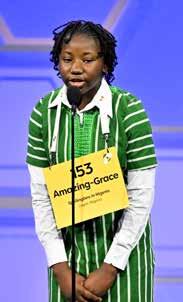
Executive directors
1928-1936 George B. Woods
1928-1938 Donald McWain
1939-1940 Douglas D. Cornette
1941-1948 Max B. Cook
1949-1956 Charles Schneider
1957-1959 Richard D. Peters
1960-1984 James H. Wagner
1985-1986 Mary L. Mangold
1985-1989 Mary Brooks
1987 Susan Miller
1988-1991 Sondra J. Austin
1990-1997 Reta Rose
1996-2020 Paige P. Kimble
2021-2022 Dr. J. Michael Durnil
2023-present Corrie Loeffler
Pronouncers
1925-1927 Dr. George S. Wills, Western Maryland College
1928-1935 Dr. Charles E. Hill, George Washington University
1936-1940, 1946-1947 Harold F. Harding, George Washington University
1938-1939 George F. Hussey Jr., special contributing editor to Webster’s New International Dictionary
1941-1942 Dr. W. Hayes Yeager, professor of public speaking, George Washington University
1948-1960 Benson S. Alleman, Department of Communications, American University
1961-1980 Dr. Richard R. Baker, professor of philosophy, University of Dayton
1981-2002 Dr. Alex J. Cameron, associate professor of English, University of Dayton
2003-present Dr. Jacques Bailly, associate professor of classics, University of Vermont
2019-present Dr. Brian Sietsema, clergyman, Greek Orthodox Archdiocese of America
2021-present Dr. Kevin Moch, software engineer, Quizlet
2022-present Christian Axelgard, doctoral candidate in Ancient Greek, University of Michigan
2025-present Vanya Shivashankar, medical student, University of Miami
2025 officials and word panelists
• Christian Axelgard, associate pronouncer
• Dr. Jacques Bailly, head pronouncer
• Mary Brooks, head judge
• Frank Cahill, word panelist
• Kristin Hawkins, judge
• Sameer Mishra, judge
• Dr. Kevin Moch, pronouncer and associate pronouncer
• Georgia Scurletis, word panelist
• Dr. Kavya Shivashankar, judge
• Mirle Shivashankar, word panelist
• Vanya Shivashankar, associate pronouncer
• Dr. Brian Sietsema, pronouncer and head associate pronouncer
• Peter Sokolowski, judge
• Jane Solomon, word panelist
• George Thampy, judge
• Barrie Trinkle, judge
• Ben Zimmer, judge